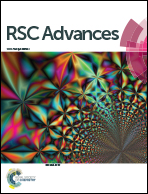Pyridylphenyl appended imidazoquinazoline based ratiometric fluorescence “turn on” chemosensor for Hg2+ and Al3+ in aqueous media†
Abstract
A highly fluorescent and efficient ratiometric ‘turn on’ probe for Hg2+ and Al3+ based on quinazoline (1) has been designed and synthesized. Limit of detection (LOD) and association constants revealed its superior binding affinity and sensitivity toward Hg2+ over Al3+. Interference studies signified displacement of the complexed Al3+ by Hg2+ which has been supported by various studies.


 Please wait while we load your content...
Please wait while we load your content...